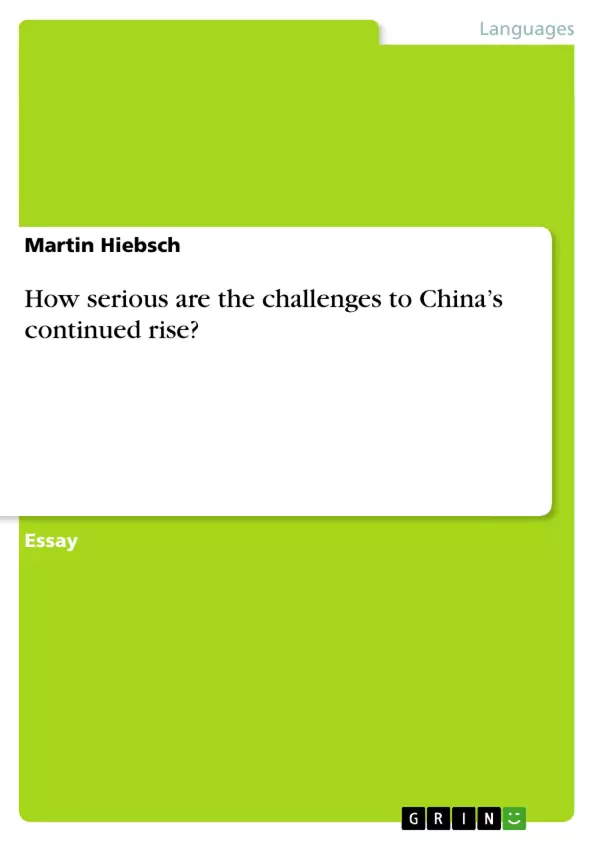The following essay will identify the key challenges to China's continued rise and weigh
their seriousness in terms of possible negative impacts to the future development of the country. It
will follow the argument that the challenges to China's continued rise are very serious and that the
impressive growth of the last decades is not sustainable and led to social injustice within the
Chinese society (YanglHeng 2012: 3).
In a first step, the author will define what he understands by "China's rise". The essay will
continue with a short overview of the challenges in order to underline the dimension and
complexity of the obstacles the Chinese government has to face. After that overview, the essay will
go into more detail and identify the economical, social and political key challenges which may
impede a further successful development. Finally, the essay will summarise its findings and provide
an outlook for the years to come.
Inhaltsverzeichnis (Table of Contents)
- Economic Challenges
- Social Challenges
- Political Challenges
Zielsetzung und Themenschwerpunkte (Objectives and Key Themes)
This essay examines the challenges to China's ongoing economic growth and assesses their seriousness in terms of potential negative impacts on the country's future development. It argues that China's impressive growth over the past few decades is unsustainable and has led to social inequality. The essay identifies and analyzes the main challenges to continued growth, categorized as economic, social, and political, and explores their potential implications for China's rise.
- The sustainability of China's economic growth model
- The impact of social inequality and demographic changes on economic growth and stability
- The role of the CCP in navigating these challenges and maintaining its legitimacy
- The implications of environmental degradation and corruption for China's future
- The influence of globalization on China's economic and political development
Zusammenfassung der Kapitel (Chapter Summaries)
This essay begins by defining China's rise as a result of its sustained economic growth and GDP increase. It then highlights the challenges posed by the current economic model, which is nearing its limits for growth. Key concerns include potential stagnation, demographic changes, and an unsustainable reliance on cheap labor and environmental exploitation. The essay further explores the risks of a property bubble, high inflation, and growing income inequality.
The essay continues by examining social challenges, including China's aging population and the implications for its financial markets and labor force. The essay notes that these factors could negatively affect economic growth and highlight the need for a stable and efficient financial system to manage capital flow and investment.
- Citation du texte
- Martin Hiebsch (Auteur), 2013, How serious are the challenges to China’s continued rise?, Munich, GRIN Verlag, https://www.grin.com/document/269694



